Comparative Study of Optimal PV Array Configurations and MPPT under Partial Shading with Fast Dynamical Change of Hybrid Load
Abstract
:1. Introduction
2. PV Module Modeling
2.1. System Modeling
2.2. Problem Formulation
2.3. Partial Shading Conditions
2.3.1. Diagonal Shading (Case 01)
2.3.2. Short and Narrow Shading (Case 02)
2.3.3. Short and Wide Shading (Case 03)
2.3.4. Long and Wide Shading (Case 04)
2.3.5. Long and Narrow Shading (Case 05)
3. Optimization Problem Formulation
- Step 1:
- Initialize PV array size (), optimization algorithms constants.
- Step 2:
- Generate the switching matrix to determine the needed PV array configuration.
- Step 3:
- Start the iteration with calculating the voltage of the PV array from Equation (6)
- Step 4:
- Calculate the generated power from the array using Equation (7). Both array voltage and power are calculated based on irradiance.
- Step 5:
- Update the parameters of the different used optimization algorithms. The velocity and positions of each population will be updated based on the associated equations.
- Step 6:
- Reconfigure the PV array and the switching matrix. The algorithms will be reinitialized whenever there is a change in solar irradiance caused by PS conditions. The change in current and voltage of the array will indicate whether the interconnection needs to be updated or not.
- Step 7:
- The process will be repeated from steps 3 to 6 until the termination criterion is met.
4. Applied Optimization Algorithms
4.1. Particle Swarm Optimization
4.2. Dragonfly Optimization Algorithm
4.3. MLSHADE-SPA Algorithm
4.4. Basic LSHADE
4.5. MLS-SPA Description
4.6. Improved Gray Wolf Optimizer
4.7. Black Widow Optimization Algorithm
5. The Proposed Performance Indices
5.1. Shading Loss
5.2. Mismatch Loss
5.3. Fill Factor
5.4. MPPT Performance
6. Simulation Results and Analysis
- Case 01, IGWO configuration gives the highest maximum power (). The BWOA configuration reached the second-best value of maximum power, yet the PSO configuration scored the lowest maximum power.
- Case 02 and Case 05, approximately all the configurations have the approximated maximum power.
- Case 03 and Case 04, IGWO algorithm generates the highest maximum power, in the second rank is the MLS-SPA.
7. Conclusions
Author Contributions
Funding
Institutional Review Board Statement
Informed Consent Statement
Data Availability Statement
Conflicts of Interest
References
- Yang, B.; Yu, T.; Zhang, X.; Li, H.; Shu, H.; Sang, Y.; Jiang, L. Dynamic leader based collective intelligence for maximum power point tracking of PV systems affected by partial shading condition. Energy Convers. Manag. 2019, 179, 286–303. [Google Scholar] [CrossRef]
- Beltran, H.; Harrison, S.; Egea-Àlvarez, A.; Xu, L. Techno-economic assessment of energy storage technologies for inertia response and frequency support from wind farms. Energies 2020, 13, 3421. [Google Scholar] [CrossRef]
- Baba, A.O.; Liu, G.; Chen, X. Classification and evaluation review of maximum power point tracking methods. Sustain. Futur. 2020, 2, 100020. [Google Scholar] [CrossRef]
- Satpathy, P.R.; Sharma, R. Parametric indicators for partial shading and fault prediction in photovoltaic arrays with various interconnection topologies. Energy Convers. Manag. 2020, 219, 113018. [Google Scholar] [CrossRef]
- Winston, D.P.; Kumaravel, S.; Kumar, B.P.; Devakirubakaran, S. Performance improvement of solar PV array topologies during various partial shading conditions. Sol. Energy 2020, 196, 228–242. [Google Scholar] [CrossRef]
- Manjunath; Suresh, H.N.; Rajanna, S. Performance enhancement of Hybrid interconnected Solar Photovoltaic array using shade dispersion Magic Square Puzzle Pattern technique under partial shading conditions. Sol. Energy 2019, 194, 602–617. [Google Scholar] [CrossRef]
- Ramli, M.A.; Twaha, S.; Ishaque, K.; Al-Turki, Y.A. A review on maximum power point tracking for photovoltaic systems with and without shading conditions. Renew. Sustain. Energy Rev. 2017, 67, 144–159. [Google Scholar] [CrossRef]
- Yadav, A.S.; Pachauri, R.K.; Chauhan, Y.K.; Choudhury, S.; Singh, R. Performance enhancement of partially shaded PV array using novel shade dispersion effect on magic-square puzzle configuration. Sol. Energy 2017, 144, 780–797. [Google Scholar] [CrossRef]
- Ul-Haq, A.; Alammari, R.; Iqbal, A.; Jalal, M.; Gul, S. Computation of power extraction from photovoltaic arrays under various fault conditions. IEEE Access 2020, 8, 47619–47639. [Google Scholar] [CrossRef]
- Tubniyom, C.; Chatthaworn, R.; Suksri, A.; Wongwuttanasatian, T. Minimization of losses in solar photovoltaic modules by reconfiguration under various patterns of partial shading. Energies 2019, 12, 24. [Google Scholar] [CrossRef] [Green Version]
- Fang, X.; Yang, Q.; Yan, W. Switching Matrix Enabled Optimal Topology Reconfiguration for Maximizing Power Generation in Series–Parallel Organized Photovoltaic Systems. IEEE Syst. J. 2021, 1–11. Available online: https://ieeexplore.ieee.org/abstract/document/9395169 (accessed on 1 January 2022). [CrossRef]
- Satpathy, P.R.; Sharma, R.; Dash, S. An efficient SD-PAR technique for maximum power generation from modules of partially shaded PV arrays. Energy 2019, 175, 182–194. [Google Scholar] [CrossRef]
- Sagar, G.; Pathak, D.; Gaur, P.; Jain, V. A Su Do Ku puzzle based shade dispersion for maximum power enhancement of partially shaded hybrid bridge-link-total-cross-tied PV array. Sol. Energy 2020, 204, 161–180. [Google Scholar] [CrossRef]
- Dhanalakshmi, B.; Rajasekar, N. A novel competence square based PV array reconfiguration technique for solar PV maximum power extraction. Energy Convers. Manag. 2018, 174, 897–912. [Google Scholar] [CrossRef]
- Dileep, G.; Singh, S. Application of soft computing techniques for maximum power point tracking of SPV system. Sol. Energy 2017, 141, 182–202. [Google Scholar] [CrossRef]
- Baimel, D.; Tapuchi, S.; Levron, Y.; Belikov, J. Improved fractional open circuit voltage MPPT methods for PV systems. Electronics 2019, 8, 321. [Google Scholar] [CrossRef] [Green Version]
- Owusu-Nyarko, I.; Elgenedy, M.A.; Ahmed, K. Combined temprature and irradiation effects on the open circuit voltage and short circuit current constants for enhancing their related pv-mppt algorithms. In Proceedings of the 2019 IEEE Conference on Power Electronics and Renewable Energy (CPERE), Aswan, Egypt, 23–25 October 2019; pp. 343–348. [Google Scholar]
- Bouakkaz, M.S.; Boukadoum, A.; Boudebbouz, O.; Bouraiou, A.; Boutasseta, N.; Attoui, I. ANN based MPPT algorithm design using real operating climatic condition. In Proceedings of the 2020 2nd International Conference on Mathematics and Information Technology (ICMIT), Adrar, Algeria, 18–19 February 2020; pp. 159–163. [Google Scholar]
- Premkumar, M.; Subramaniam, U.; Babu, T.S.; Elavarasan, R.M.; Mihet-Popa, L. Evaluation of mathematical model to characterize the performance of conventional and hybrid PV array topologies under static and dynamic shading patterns. Energies 2020, 13, 3216. [Google Scholar] [CrossRef]
- Mohamed, M.A.; Diab, A.A.Z.; Rezk, H. Partial shading mitigation of PV systems via different meta-heuristic techniques. Renew. Energy 2019, 130, 1159–1175. [Google Scholar] [CrossRef]
- Almadhor, A.; Rauf, H.T.; Khan, M.A.; Kadry, S.; Nam, Y. A hybrid algorithm (BAPSO) for capacity configuration optimization in a distributed solar PV based microgrid. Energy Rep. 2021, 7, 7906–7912. [Google Scholar] [CrossRef]
- Hassan, T.u.; Abbassi, R.; Jerbi, H.; Mehmood, K.; Tahir, M.F.; Cheema, K.M.; Elavarasan, R.M.; Ali, F.; Khan, I.A. A novel algorithm for MPPT of an isolated PV system using push pull converter with fuzzy logic controller. Energies 2020, 13, 4007. [Google Scholar] [CrossRef]
- Phanden, R.K.; Sharma, L.; Chhabra, J.; Demir, H.İ. A novel modified ant colony optimization based maximum power point tracking controller for photovoltaic systems. Mater. Today Proc. 2021, 38, 89–93. [Google Scholar] [CrossRef]
- Ajmal, A.M.; Ramachandaramurthy, V.K.; Naderipour, A.; Ekanayake, J.B. Comparative analysis of two-step GA-based PV array reconfiguration technique and other reconfiguration techniques. Energy Convers. Manag. 2021, 230, 113806. [Google Scholar] [CrossRef]
- Yousri, D.; Babu, T.S.; Beshr, E.; Eteiba, M.B.; Allam, D. A robust strategy based on marine predators algorithm for large scale photovoltaic array reconfiguration to mitigate the partial shading effect on the performance of PV system. IEEE Access 2020, 8, 112407–112426. [Google Scholar] [CrossRef]
- Krishna, G.S.; Moger, T. Improved SuDoKu reconfiguration technique for total-cross-tied PV array to enhance maximum power under partial shading conditions. Renew. Sustain. Energy Rev. 2019, 109, 333–348. [Google Scholar] [CrossRef]
- Yousri, D.; Thanikanti, S.B.; Allam, D.; Ramachandaramurthy, V.K.; Eteiba, M. Fractional chaotic ensemble particle swarm optimizer for identifying the single, double, and three diode photovoltaic models’ parameters. Energy 2020, 195, 116979. [Google Scholar] [CrossRef]
- Babu, T.S.; Ram, J.P.; Sangeetha, K.; Laudani, A.; Rajasekar, N. Parameter extraction of two diode solar PV model using Fireworks algorithm. Sol. Energy 2016, 140, 265–276. [Google Scholar] [CrossRef]
- Allam, D.; Yousri, D.; Eteiba, M. Parameters extraction of the three diode model for the multi-crystalline solar cell/module using Moth-Flame Optimization Algorithm. Energy Convers. Manag. 2016, 123, 535–548. [Google Scholar] [CrossRef]
- Ibrahim, I.A.; Hossain, M.; Duck, B.C.; Fell, C.J. An adaptive wind-driven optimization algorithm for extracting the parameters of a single-diode PV cell model. IEEE Trans. Sustain. Energy 2019, 11, 1054–1066. [Google Scholar] [CrossRef]
- Pendem, S.R.; Mikkili, S. Modeling, simulation and performance analysis of solar PV array configurations (Series, Series–Parallel and Honey-Comb) to extract maximum power under Partial Shading Conditions. Energy Rep. 2018, 4, 274–287. [Google Scholar] [CrossRef]
- Pendem, S.R.; Mikkili, S. Modelling and performance assessment of PV array topologies under partial shading conditions to mitigate the mismatching power losses. Sol. Energy 2018, 160, 303–321. [Google Scholar] [CrossRef]
- Pilakkat, D.; Kanthalakshmi, S. An improved P&O algorithm integrated with artificial bee colony for photovoltaic systems under partial shading conditions. Sol. Energy 2019, 178, 37–47. [Google Scholar]
- Azar, A.T.; Ammar, H.H.; Ibrahim, Z.F.; Ibrahim, H.A.; Mohamed, N.A.; Taha, M.A. Implementation of PID controller with PSO tuning for autonomous vehicle. In Proceedings of the International Conference on Advanced Intelligent Systems and Informatics, Cairo, Egypt, 26–28 October 2019; pp. 288–299. [Google Scholar]
- Babu, T.S.; Ram, J.P.; Dragičević, T.; Miyatake, M.; Blaabjerg, F.; Rajasekar, N. Particle swarm optimization based solar PV array reconfiguration of the maximum power extraction under partial shading conditions. IEEE Trans. Sustain. Energy 2017, 9, 74–85. [Google Scholar] [CrossRef]
- Optimal Reconfiguration of Solar Photovoltaic Arrays Using a Fast Parallelized Particle Swarm Optimization in Confront of Partial Shading. Int. J. Eng. 2019, 32, 1177–1185. [CrossRef] [Green Version]
- Mirjalili, S. Dragonfly algorithm: A new meta-heuristic optimization technique for solving single-objective, discrete, and multi-objective problems. Neural Comput. Appl. 2016, 27, 1053–1073. [Google Scholar] [CrossRef]
- Reynolds, C.W. Flocks, herds and schools: A distributed behavioral model. In Proceedings of the 14th Annual Conference on Computer Graphics and Interactive Techniques, Anaheim, CA, USA, 27–31 July 1987; pp. 25–34. [Google Scholar]
- Vedik, B.; Kumar, R.; Deshmukh, R.; Verma, S.; Shiva, C.K. Renewable Energy-Based Load Frequency Stabilization of Interconnected Power Systems Using Quasi-Oppositional Dragonfly Algorithm. J. Control. Autom. Electr. Syst. 2021, 32, 227–243. [Google Scholar] [CrossRef]
- Tanabe, R.; Fukunaga, A.S. Improving the search performance of SHADE using linear population size reduction. In Proceedings of the 2014 IEEE Congress on Evolutionary Computation (CEC), Beijing, China, 6–11 July 2014; pp. 1658–1665. [Google Scholar]
- Hao, Q.; Zhou, Z.; Wei, Z.; Chen, G. Parameters Identification of Photovoltaic Models Using a Multi-Strategy Success-History-Based Adaptive Differential Evolution. IEEE Access 2020, 8, 35979–35994. [Google Scholar] [CrossRef]
- Wei, Z.; Huang, C.; Wang, X.; Zhang, H. Parameters identification of photovoltaic models using a novel algorithm inspired from nuclear reaction. In Proceedings of the 2019 IEEE Congress on Evolutionary Computation (CEC), Wellington, New Zealand, 10–13 June 2019; pp. 210–218. [Google Scholar] [CrossRef]
- Nadimi-Shahraki, M.H.; Taghian, S.; Mirjalili, S. An improved grey wolf optimizer for solving engineering problems. Expert Syst. Appl. 2021, 166, 113917. [Google Scholar] [CrossRef]
- Hayyolalam, V.; Pourhaji Kazem, A.A. Black Widow Optimization Algorithm: A novel meta-heuristic approach for solving engineering optimization problems. Eng. Appl. Artif. Intell. 2020, 87, 103249. [Google Scholar] [CrossRef]
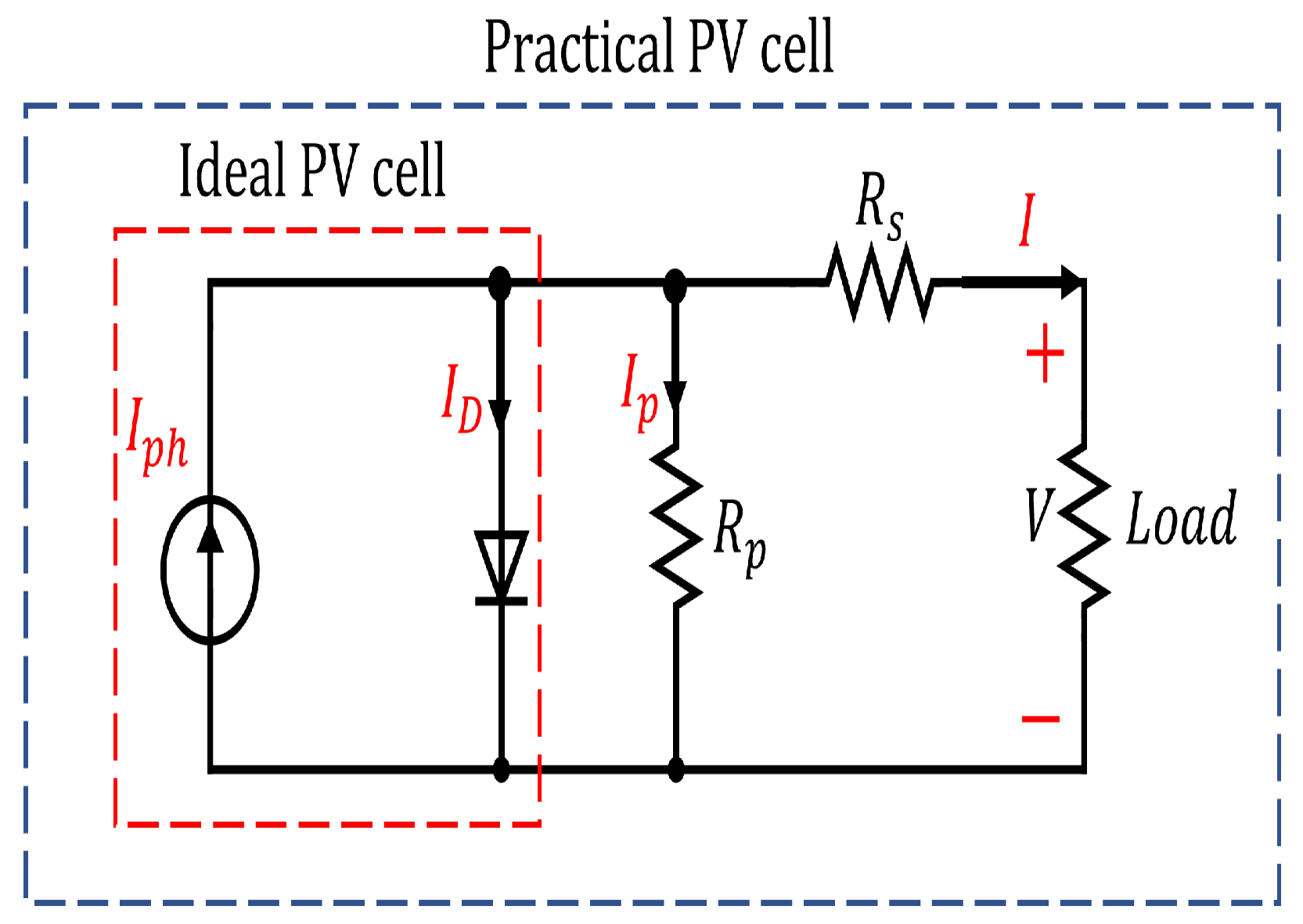
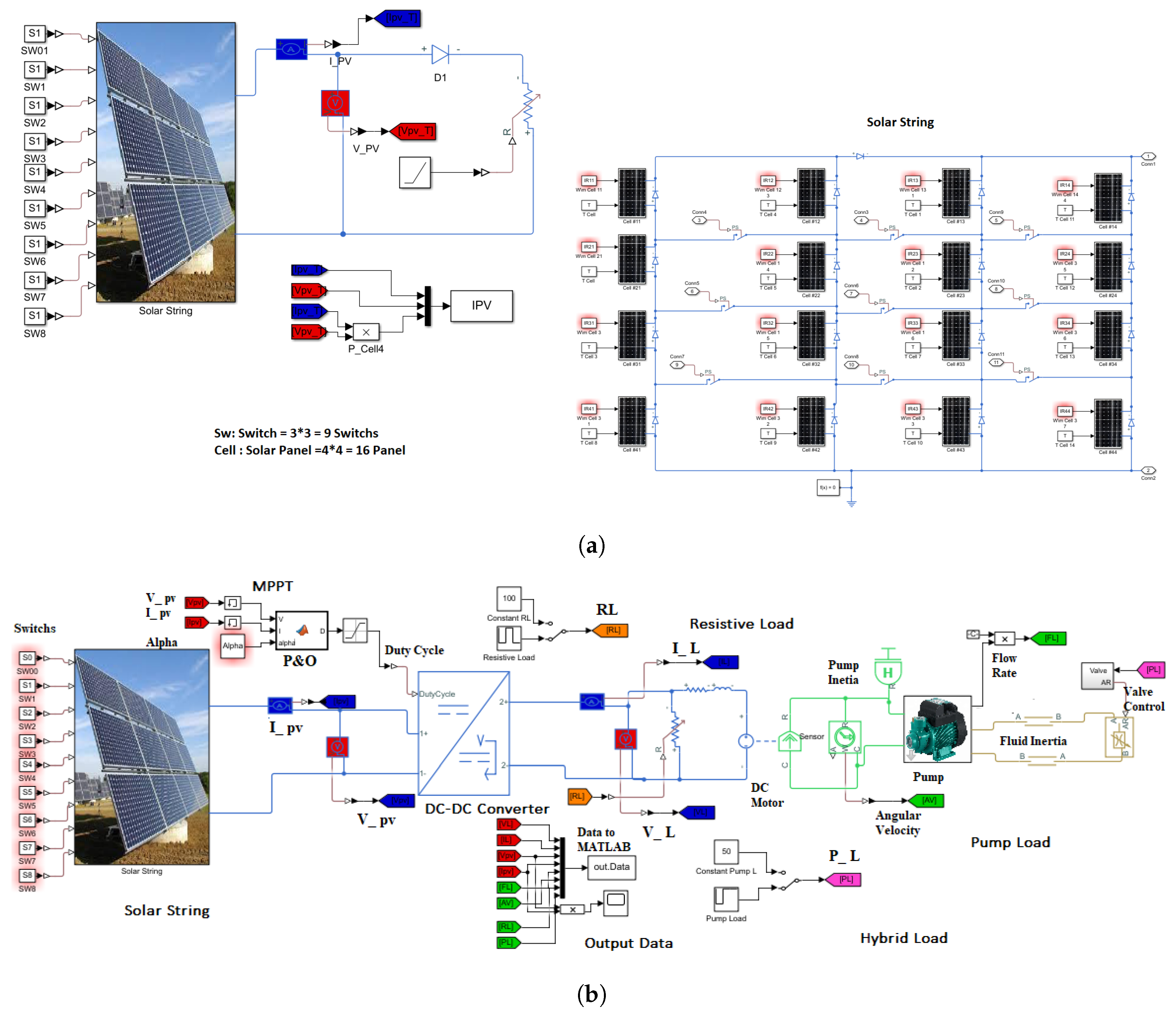
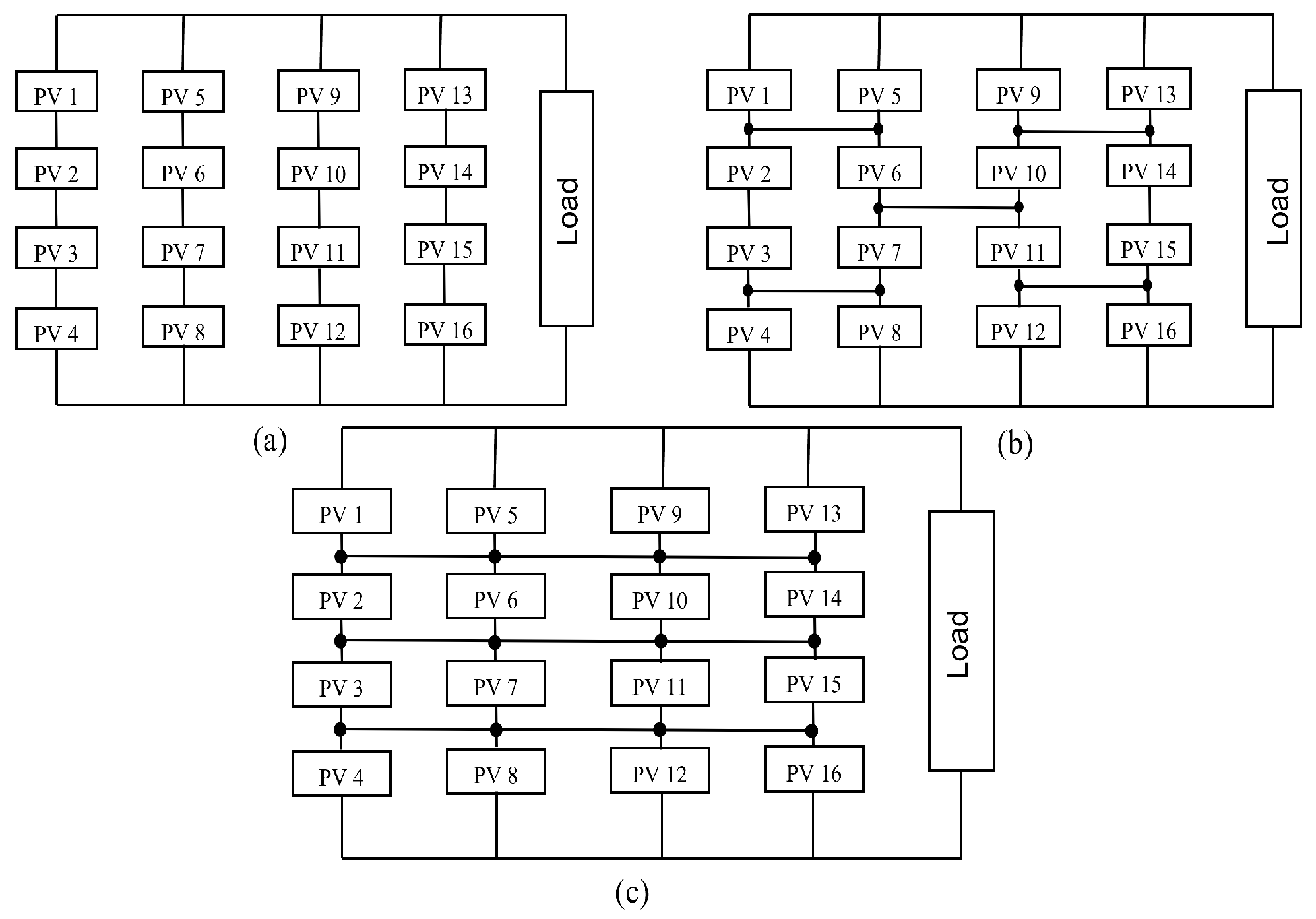
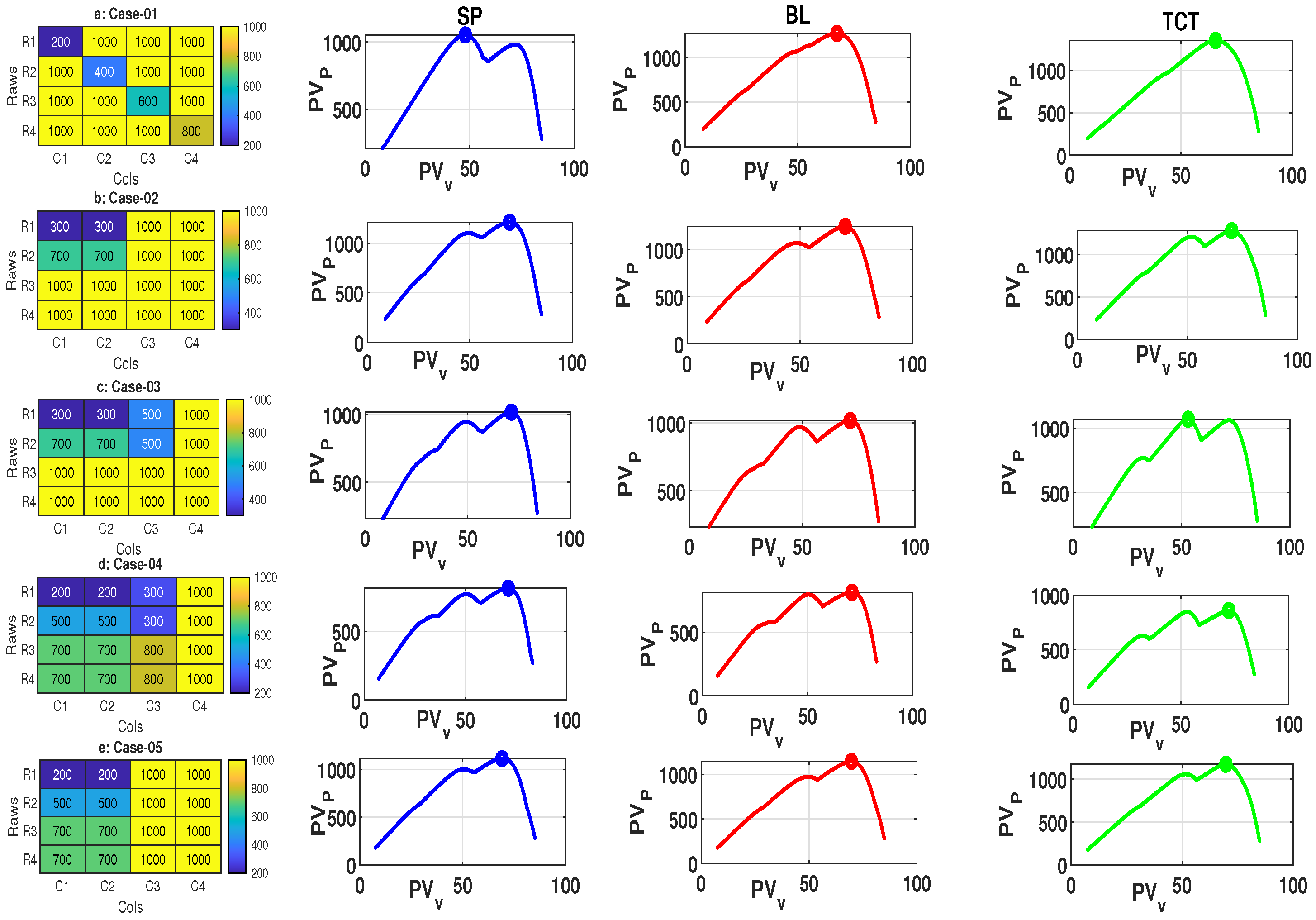

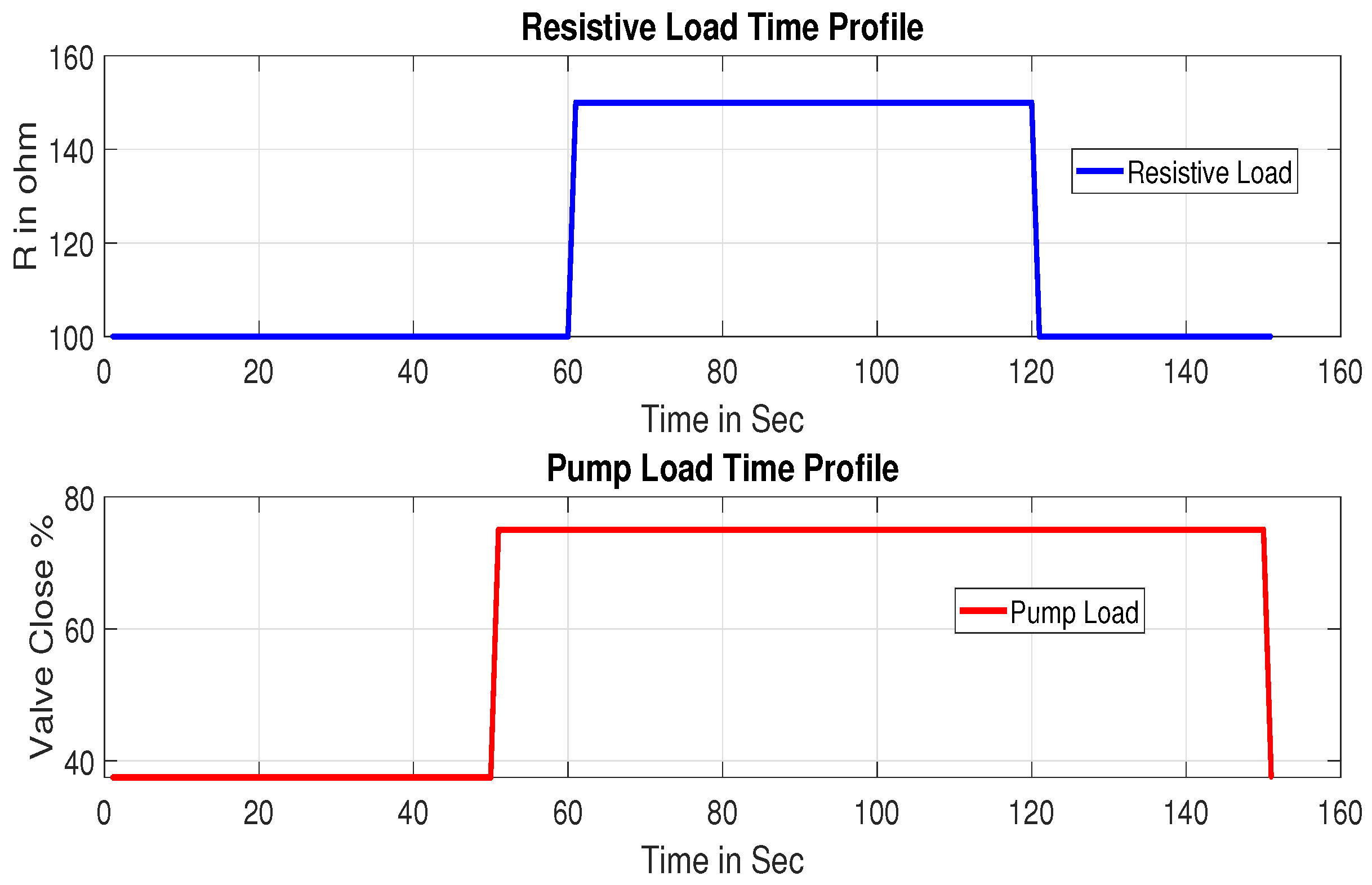

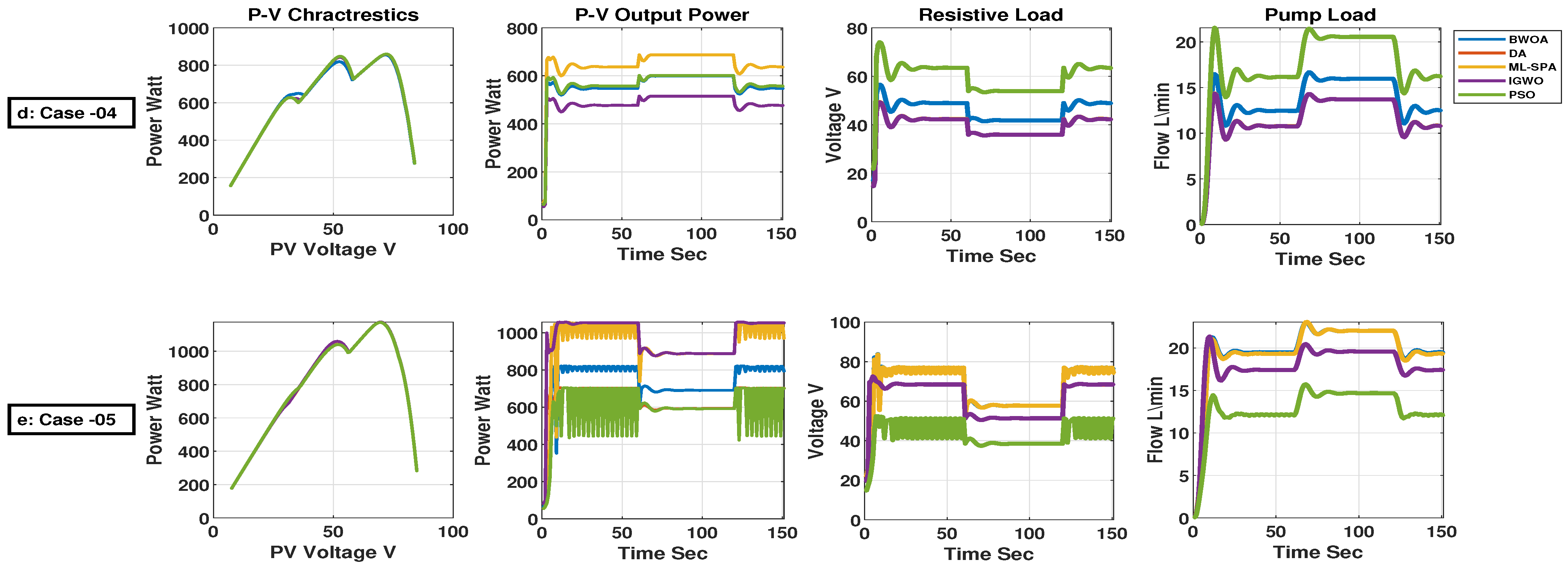
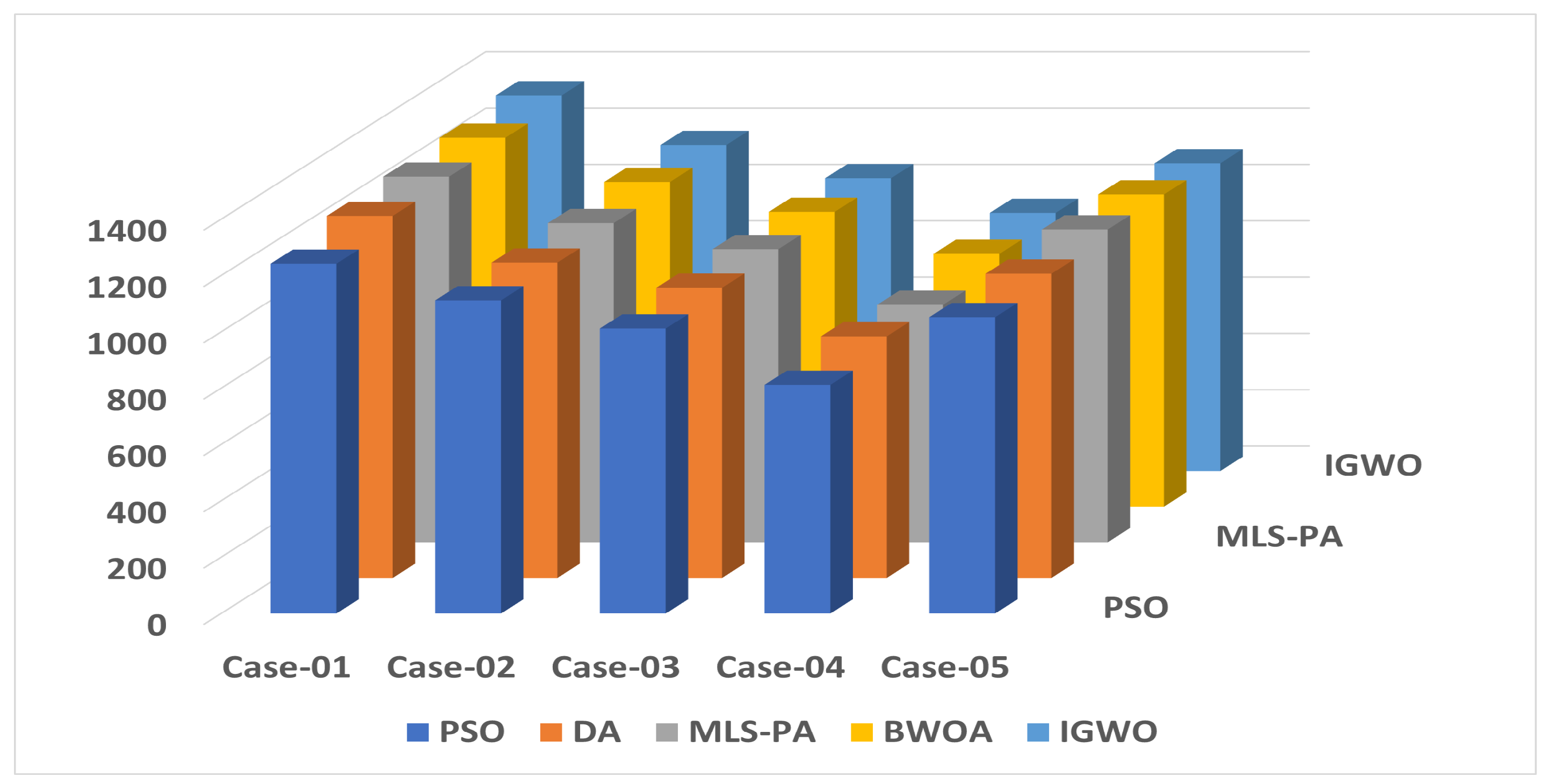
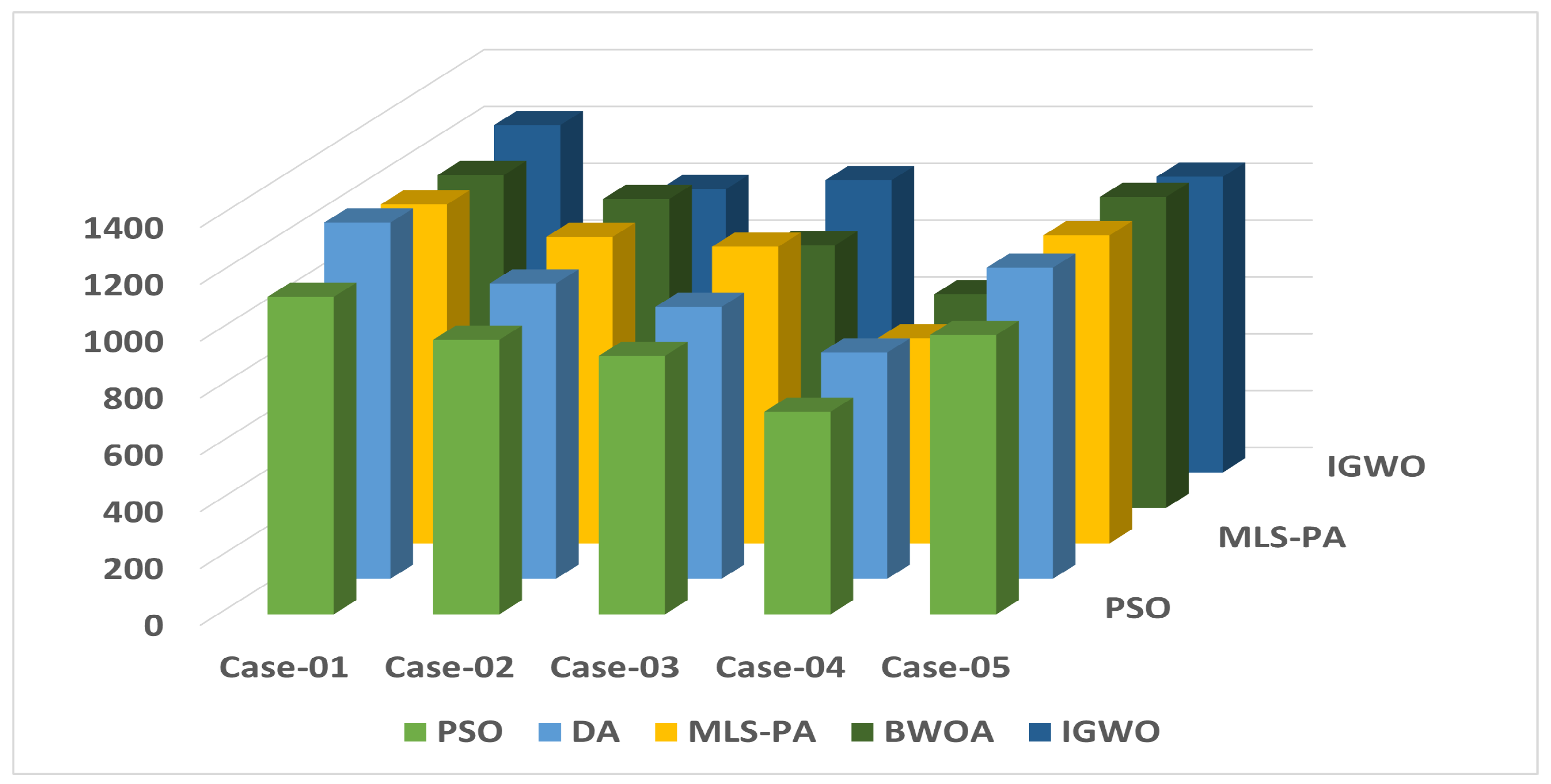
| Parameter | Variable | Value |
|---|---|---|
| Maximum power | ||
| Maximum power point voltage | ||
| Maximum power point current | ||
| Open circuit voltage | ||
| Short circuit current | ||
| Number of series cell | 72 | |
| Temperature coefficient of Isc |
| Configuration | |||
|---|---|---|---|
| 1452 | |||
| 1480 | |||
| 1542 |
| Cases | |
|---|---|
| Case 01 | |
| Case 02 | |
| Case 03 | |
| Case 04 | |
| Case 05 |
| Bio-Inspired MPPT | PSO | DA | MLS-SPA | BWOA | IGWO | |
|---|---|---|---|---|---|---|
| Average tracking time | Case-01 | 2.5 s | 1.95 s | 2.1 s | 1.65 s | 1.52 s |
| Case-02 | 2.82 s | 1.86 s | 1.93 s | 1.75 s | 1.67 s | |
| Case-03 | 3.1 s | 2.4 s | 2.17 s | 1.85 s | 1.71 s | |
| Case-04 | 2.74 s | 1.95 s | 1.77 s | 1.32 s | 1.41 s | |
| Case-05 | 1.88 s | 1.73 s | 1.43 s | 1.26 s | 1.22 s | |
| Average | 2.608 s | 1.978 s | 1.88 s | 1.566 s | 1.506 s | |
| Mismatch loss % | Case-01 | 1.21 | 1.18 | 1.13 | 1.14 | 1.13 |
| Case-02 | 2.38 | 1.41 | 2.31 | 1.36 | 1.42 | |
| Case-03 | 4.27 | 3.79 | 4.72 | 3.42 | 3.12 | |
| Case-04 | 2.19 | 9.02 | 8.03 | 4.32 | 2.85 | |
| Case-05 | 6.12 | 7.34 | 12.35 | 3.78 | 4.17 | |
| Average | 3.234 | 4.548 | 5.708 | 2.804 | 2.538 | |
| Fill factor | Case-01 | 0.24 | 0.71 | 0.63 | 0.76 | 0.74 |
| Case-02 | 0.38 | 0.41 | 0.54 | 0.67 | 0.79 | |
| Case-03 | 0.42 | 0.61 | 0.68 | 0.74 | 0.77 | |
| Case-04 | 0.37 | 0.64 | 0.72 | 0.68 | 0.82 | |
| Case-05 | 0.45 | 0.57 | 0.69 | 0.81 | 0.83 | |
| Average | 0.372 | 0.588 | 0.652 | 0.732 | 0.79 | |
| Shading loss (W) | Case-01 | 168 | 128 | 131 | 118 | 121 |
| Case-02 | 142 | 115 | 105 | 103 | 104 | |
| Case-03 | 126 | 109 | 102 | 116 | 101 | |
| Case-04 | 166 | 133 | 114 | 117 | 102 | |
| Case-05 | 125 | 112 | 98 | 87 | 79 | |
| Average | 145.4 | 119.4 | 110 | 108.2 | 101.4 | |
| Response to load variations | Slow | Slow | Average | Fast | Fast | |
| MPPT average efficiency | 91.6 | 94.7 | 95.1 | 97.41 | 98.23 | |
Publisher’s Note: MDPI stays neutral with regard to jurisdictional claims in published maps and institutional affiliations. |
© 2022 by the authors. Licensee MDPI, Basel, Switzerland. This article is an open access article distributed under the terms and conditions of the Creative Commons Attribution (CC BY) license (https://creativecommons.org/licenses/by/4.0/).
Share and Cite
Boghdady, T.A.; Kotb, Y.E.; Aljumah, A.; Sayed, M.M. Comparative Study of Optimal PV Array Configurations and MPPT under Partial Shading with Fast Dynamical Change of Hybrid Load. Sustainability 2022, 14, 2937. https://doi.org/10.3390/su14052937
Boghdady TA, Kotb YE, Aljumah A, Sayed MM. Comparative Study of Optimal PV Array Configurations and MPPT under Partial Shading with Fast Dynamical Change of Hybrid Load. Sustainability. 2022; 14(5):2937. https://doi.org/10.3390/su14052937
Chicago/Turabian StyleBoghdady, Tarek A., Yasmin E. Kotb, Abdullah Aljumah, and Mahmoud M. Sayed. 2022. "Comparative Study of Optimal PV Array Configurations and MPPT under Partial Shading with Fast Dynamical Change of Hybrid Load" Sustainability 14, no. 5: 2937. https://doi.org/10.3390/su14052937
APA StyleBoghdady, T. A., Kotb, Y. E., Aljumah, A., & Sayed, M. M. (2022). Comparative Study of Optimal PV Array Configurations and MPPT under Partial Shading with Fast Dynamical Change of Hybrid Load. Sustainability, 14(5), 2937. https://doi.org/10.3390/su14052937








